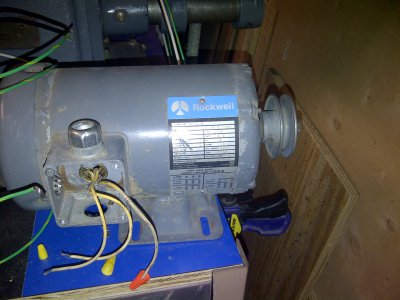- Joined
- Feb 23, 2012
- Messages
- 43
Hi everyone,
I finally got my Burke #2 back together and was going to setup an RPC to run the gear motor on it.
When I purchased the burke, the seller threw in another 3 phase telling me that I could build a RPC from it. (did a google search on how to wire)
I wanted to test the whole RPC setup and figure out what size run capacitors I would need..
I hooked up the extra motor as follows:
L1 (as indicated on the wire) -- 1 leg of the 220 Circuit out of the wall and to 2 capacitors wired in parallel, 40 mf and 15 mf (I bought a whole assortment as I wasnt sure what i needed).
L2 -- 2nd leg of the 220 circuit out of the wall
L3 -- to a momentary switch which then goes to the other side of the caps.
ground to the frame of the motor.
turned off the circuit breaker, plugged the wire in.. turned on the circuit breaker expecting to have to hit the switch to get it started.. low and behold the motor started spinning w/o me touching the switch (i checked the switch to make sure it was infinite resistance as is and 0 resistance when the button was pressed).
thought maybe the caps were in the circuit somehow so I pulled the wires to take them out of the circuit completely.. the motor still starts??
questions:
1. is it possible this was converted to 1 phase (i doubt it since the wires say l1, l2, and l3)?
2. it the motor going to burn out ( i only ran a few seconds each try since I was not expecting this)? if so what should I be looking at/testing?
3. if not, do i still need start (and run capacitors)?
thank you,
Roger
some info on the label of the motor:
Rockwell 1 hp motor, manufactured by baldor. 1725 rpm, 4.4 amps, 3 phase. rockwell no 66-018


I finally got my Burke #2 back together and was going to setup an RPC to run the gear motor on it.
When I purchased the burke, the seller threw in another 3 phase telling me that I could build a RPC from it. (did a google search on how to wire)
I wanted to test the whole RPC setup and figure out what size run capacitors I would need..
I hooked up the extra motor as follows:
L1 (as indicated on the wire) -- 1 leg of the 220 Circuit out of the wall and to 2 capacitors wired in parallel, 40 mf and 15 mf (I bought a whole assortment as I wasnt sure what i needed).
L2 -- 2nd leg of the 220 circuit out of the wall
L3 -- to a momentary switch which then goes to the other side of the caps.
ground to the frame of the motor.
turned off the circuit breaker, plugged the wire in.. turned on the circuit breaker expecting to have to hit the switch to get it started.. low and behold the motor started spinning w/o me touching the switch (i checked the switch to make sure it was infinite resistance as is and 0 resistance when the button was pressed).
thought maybe the caps were in the circuit somehow so I pulled the wires to take them out of the circuit completely.. the motor still starts??
questions:
1. is it possible this was converted to 1 phase (i doubt it since the wires say l1, l2, and l3)?
2. it the motor going to burn out ( i only ran a few seconds each try since I was not expecting this)? if so what should I be looking at/testing?
3. if not, do i still need start (and run capacitors)?
thank you,
Roger
some info on the label of the motor:
Rockwell 1 hp motor, manufactured by baldor. 1725 rpm, 4.4 amps, 3 phase. rockwell no 66-018



